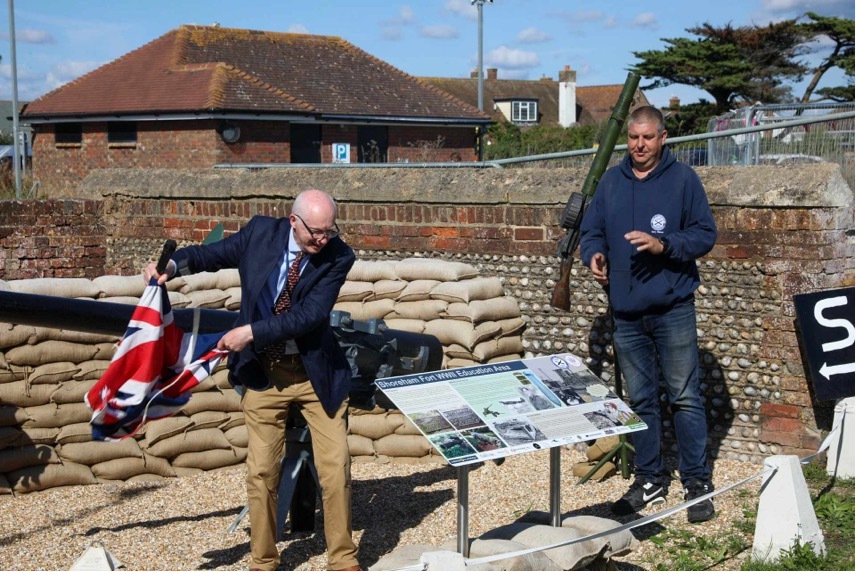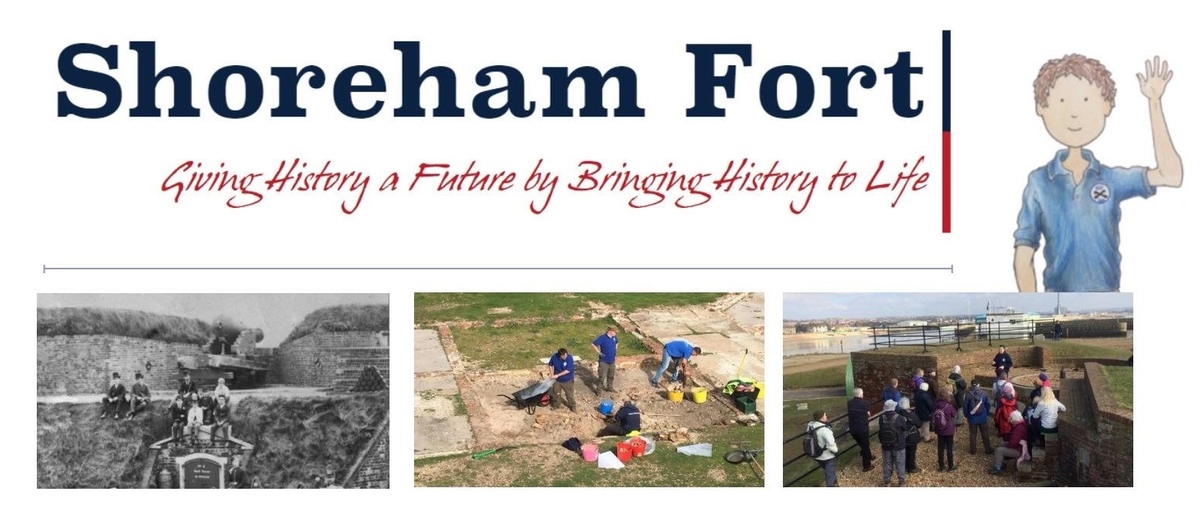
In May 2024 the Fortress Study Group was pleased to award the Friends of Shoreham Fort a grant to assist in creating a new WW2 education experience in the Fort. In this article Sharon Penfold from Shoreham Fort tells us about how they are using the grant.
Shoreham Fort’s New WW2 education area including an Immersive Air Raid Shelter Experience.
Shoreham Fort, a historic Victorian coastal fortification in West Sussex, has introduced a brand-new educational WW2 area and immersive ‘Air Raid Shelter Experience’ that transports visitors back to the harrowing days of the Second World War.
This engaging attraction offers a unique opportunity to experience what life was like for civilians during the relentless air raids of the Blitz, making it one of the fort’s compelling educational offerings. This has been built on the west side of the parade ground and in the West Caponier and has all been made possible by funding, grants and gifts in kind from multiple organisations including Fortress Study Group, Asda Foundation, Gardiner and Scardifield, local Rotary and Lions clubs, Shoreham Port Authority, Highdown Car Audio & Security, Universal Matter, Chapel Bay Fort, LC Packaging, Mills Antique Metal Restorations, Steps Back In Time and the Lancing and Sompting Men In Sheds.
The new area was officially open by Andy Bliss, former High Sheriff of West Sussex on the 14th September 2024 as part of the ‘Heritage Open Days’ event at Shoreham Fort
Photo taken by Craig Searle shows Andy Bliss unveiling the new WW2 experience information board and Gary Baines (Founder/Chairman Friends of Shoreham Fort)
If you would like to support future FSG Grants please consider giving a donation using the following link.
In 2024 FSG will match your donations up to a total of £3000 with the aim of having £6000 to offer in grants.
FSG fundraising appeal

A Journey into Wartime Britain
The Air Raid Shelter Experience at Shoreham Fort recreates the atmosphere of the 1940s, when ordinary British citizens faced the threat of bombing during one of the most turbulent periods in the nation's history. The shelter, built to mimic the cramped, dark, and uncomfortable conditions of the real wartime structures, uses technology to provide an authentic and immersive experience that brings to life the challenges and fears endured by millions during World War II.
As visitors step into the recreated shelter, they are immediately immersed in the sights, sounds, and even the feel of wartime Britain. Dim lighting, the whine of air raid sirens, distant explosions, and the tense silence of waiting out a raid create an eerily realistic environment. Visitors can hear the historical voices of radio broadcasts urging people to "keep calm and carry on," alongside the ever-present threat of bomb blasts.
The experience isn’t just about creating atmosphere—it’s also deeply educational. Throughout the tour, knowledgeable guides provided historical context, explaining how air raids impacted civilian life, the development and importance of shelters, and the efforts of communities to cope with these terrifying events. For many, these shelters were the last line of defence as bombs fell from the sky, and the experience helps modern-day visitors connect with the resilience and bravery of wartime civilians.

Educational Value
Beyond the immersive thrills, the Air Raid Shelter Experience offers significant educational benefits. It provides a vivid portrayal of the civilian side of war, focusing on the resilience, resourcefulness, and community spirit that defined the British home front during WW2. This is especially valuable for younger visitors, giving them an understanding of how war impacted ordinary people in their homes and towns, far from the battlefield.
School groups visiting the fort can engage in hands-on history lessons, using the air raid shelter as a live learning environment. The experience aligns with the history curriculum and helps students understand broader themes such as the effects of war on civilian populations, how governments prepare for national emergencies, and the social dynamics of wartime Britain. Special educational tours offer opportunities for students to interact with artifacts, role-play historical scenarios, and ask questions about this critical period in history. Added to this, the unique and diverse history of Shoreham Fort itself and the WW1 Trench Experience, this really is the ideal place for schools to visit to learn in an interactive and personal way rather than reading about it in books or viewing behind glass.

Giving History a Future by Bringing History to Life
The air raid shelter is part of a broader effort by the Friends of Shoreham Fort as part of their motto Giving History a Future by Bringing History to Life to enhance the educational value of the fort and create more interactive, engaging experiences for visitors. It stands as a reminder of the fort’s WW2 heritage, when it played a part in defending the British coastline against a possible invasion by Nazi forces.
During the war, Shoreham Fort and other coastal defence structures were repurposed to monitor coastal activities, prevent enemy landings, and defend against air and sea raids. While the fort originally dates back to the Victorian era, this WWII connection has given it a renewed historical importance and is helping to put Shoreham back on the map with regards to D-Day too.
Through this experience, Shoreham Fort highlights not just its own role in WW2, but the local area and the collective effort of Britain’s people in surviving the Blitz. The fort’s commitment to bringing history to life makes it a destination for history enthusiasts, families, and school groups eager to connect with the past in meaningful ways.
Grant Details
Recipient - Friends of Shoreham Fort
Purpose – To create a WW2 area at Shoreham Fort to complement the recently built WW1 Memorial Trench and to open the previously vandalised West Caponier for the first time to the public as an air raid shelter experience. This will further help with our hands on history approach when bringing schools to the site. The WW2 area will also incorporate two guns and will build a retaining wall from sandbags to make the area safe (there is a 5' drop from parade ground to ditch) but also give the impression of going underground. This grant will be used for materials towards the build and to research and design the information panel incorporated into the project with FSG logo being included on the panel itself.
Value - £1500
Co-funding – the grant represented 50% of the cost
Date Awarded – May 2024




